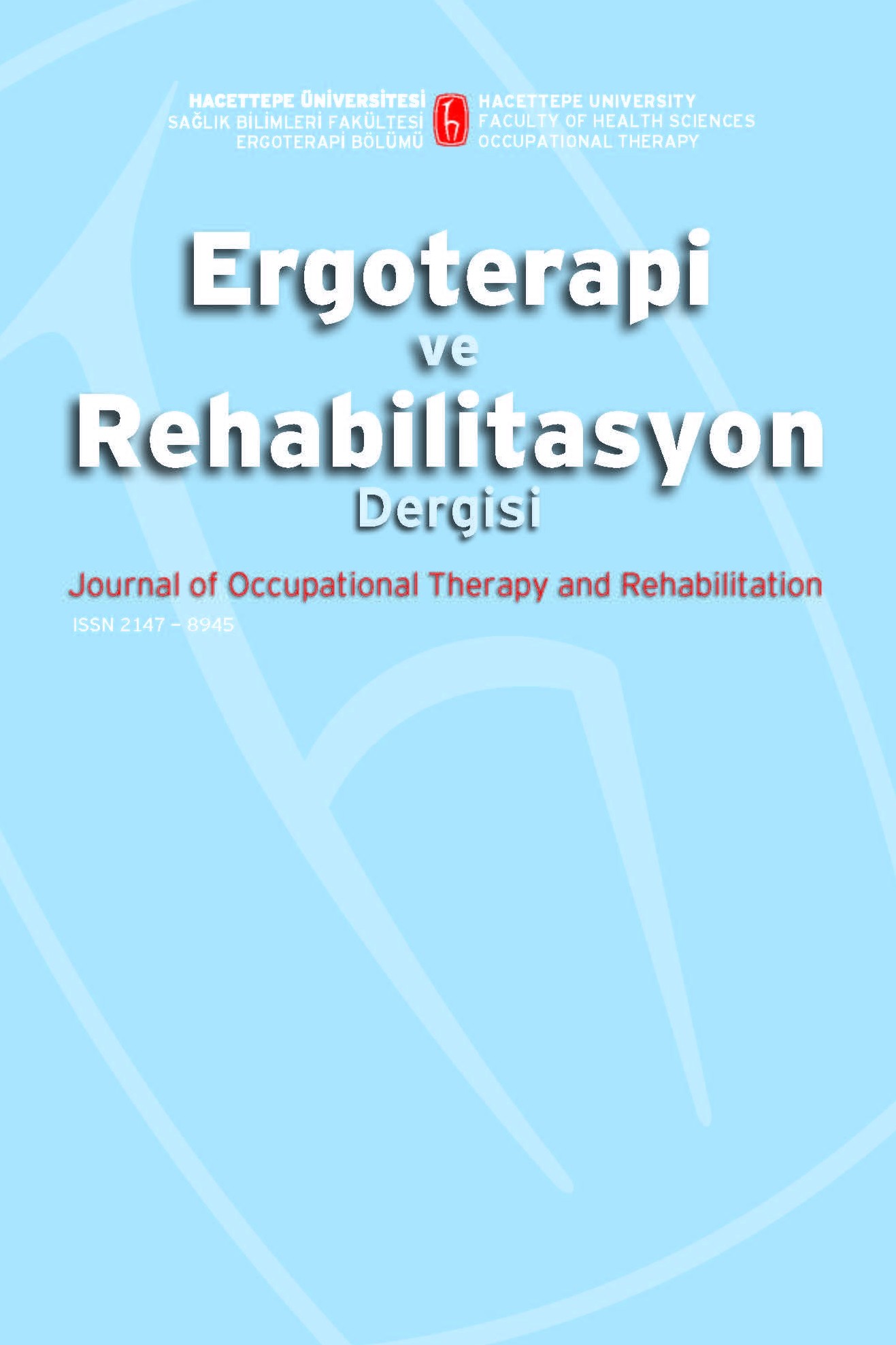Winchester Sendromlu Bir Olguda Fizyoterapi ve Ergoterapinin Etkileri
Amaç: Çalışmanın amacı, Winchester Sendromu olan bir vakada fizyoterapi ve ergoterapinin etkilerini araştırmaktır. Gereç ve yöntem: Bu raporda, Winchester Sendromu olan 13 yaşında bir erkek çocuğu ve uygulanan fizyoterapi ve ergoterapi yaklaşımları sunuldu. Kamakura’s El Kavramaları Değerlendirme Yöntemi ve Kanada Aktivite Performans Ölçeği, el becerileri ve günlük yaşam aktivitelerindeki performansı değerlendirmek için kullanıldı. Cümleleri yazma süresi ve el fonksiyonları Jebsen Taylor El Fonksiyon Testi ile değerlendirildi. İnce motor beceriler Bruininks-Oseretsky Motor Beceri Testi’nin ince motor beceri alt testi ile, günlük yaşam aktiviteleri çocuklar için Fonksiyonel Bağımsızlık Ölçeği (WeeFIM) ile ve yaşam kalitesi Çocuk Sağlık Değerlendirme Anketi (CHAQ) ile değerlendirildi. Olgunun eklem hareket açıklığı ve postür analizi yapıldı. Fiziksel fonksiyonları ve motor becerileri artırmaya yönelik fizyoterapi ve ergoterapi yaklaşımlarını içeren egzersiz ve aktivite çalışmaları planlandı, 6 ay boyunca düzenli olarak haftada 3 gün uygulandı. Sonuçlar: Olgunun eklem hareket açıklığı, günlük yaşam aktivitelerindeki bağımsızlığı, yaşam kalitesi ve aktivite katılımının tedavi sonrasında arttığı bulundu. Tartışma: Winchester sendromlu vakalarda fizyoterapi ve ergoterapi yaklaşımları önemli bir tedavi seçeneği olabileceği sonucuna varıldı
Anahtar Kelimeler:
Winchester sendromu, Fizyoterapi, Ergoterap, Nöromusküler hastalıklar
Effects of Physiotherapy and Occupational Therapy in A Case with Winchester Syndrome
Purpose: The aim of this study was to investigate the effects of physiotherapy and occupational therapy in a case with Winchester syndrome. Material and methods: In this report, 13 years old boy with Winchester Syndrome and physical and occupational therapy approaches were presented. Kamakura’s Hand Grips Evaluation Method, Canadian Occupational Performance Measure were used to assess hand ability and performance in daily living activities. Duration of writing sentences and hand functions were assessed by Jebsen Taylor Hand Function Test. Fine motor skills were assessed by using the fine motor skills’ subtests of Bruininks- Oseretsky Motor Proficiency Test, activities of daily living by Functional Independence Measurement for children (Wee-FIM), and quality of life by Child Assessment of Health Questionnaire (CHAQ). The range of motions and posture analysis of the subject were also examined. Exercise and activity trainings that included physiotherapy and occupational therapy approaches were planned to increase physical functions and ability in motor skills and performed 3 days in a week during six months regularly. Results: The range of motions of joints, independency level in daily living activities and quality of life of the subject were improved obviously after trainings. conclusion: It is concluded that physiotherapy and occupational therapy approaches may be one of the important supportive therapeutic options for the cases with Winchester Syndrome
- ISSN: 2147-8945
- Yayın Aralığı: Yılda 3 Sayı
- Başlangıç: 2013
- Yayıncı: Hacettepe Üniversitesi Sağlık Bilimleri Fakültesi
Sayıdaki Diğer Makaleler
Amatör Sporcu Çocuklarda Benign Eklem Hipermobilitesi, Ağrı ve Yaşam Kalitesinin İncelenmesi
Muhammed KILINÇ, Sibel Aksu YILDIRIM, Hülya KAYIHAN
Meral HURİ, Esra AKI, Gonca BUMİN, Fatih KAREL
Fizyoterapistlerin Çalişma Kapasitesinin Belirlenmesi
Winchester Sendromlu Bir Olguda Fizyoterapi ve Ergoterapinin Etkileri
Songül ATASAVUN UYSAL, İpek ALEMDAROĞLU, Öznur YILMAZ, Hülya KAYIHAN, Ayşe KARADUMAN
